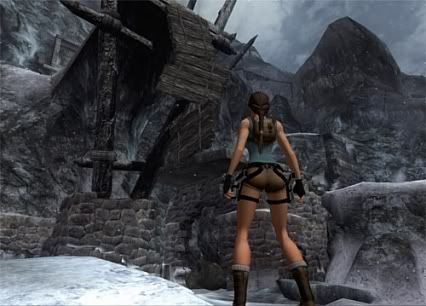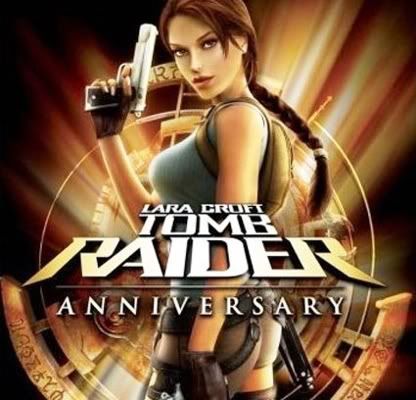Tomb Raider: Anniversary is a few years old now, but as a former fan of the series, I became curious about this remake. What I got was a technically improved version of the original game, minus all the heart that left me with such fond memories. This got me thinking about how the recent trends in story-telling may be hindering games as much as they help.
The original Tomb Raider was one of the premiere video games of the mid-90s. It came at a time before Nintendo Wii and Halo, when video games were still an embarrassing hobby. And it probably didn’t do us any favors when it prominently featured Lara Croft, and her impossible bust, right on the front cover. Despite that, or because of it, she became a household name.
Lara was exciting to a lot of people (men and women) because she was essentially a superwoman. She fought bears and raptors with a Desert Eagle in each hand. She climbed to the highest reaches with the grace of an acrobat. She was a book smart archaeologist with quick wits and a snarky tone. She killed men and gods. Breast size aside, she became the James Cameron-esque action-feminist spokeswoman for video games. She was as recognizable to the mainstream American as Mario and Mortal Kombat.
 While Lara became a cultural icon, her game was highly regarded among the actual game-playing audience. Tomb Raider was, in a lot of ways, sophisticated for its time. It downplayed combat in favor of exploration and puzzle-solving. You shot at things, but it was only a way to break up long stretches of desolate tomb-raiding. Furthermore, the story was clever – it wasn’t a brilliant plot by any stretch, but the dialogue was brisk and funny. Lara came off as a smart daredevil with a sense of humour. The game’s cutscenes are still entertaining today, graphical wrinkles and all.
While Lara became a cultural icon, her game was highly regarded among the actual game-playing audience. Tomb Raider was, in a lot of ways, sophisticated for its time. It downplayed combat in favor of exploration and puzzle-solving. You shot at things, but it was only a way to break up long stretches of desolate tomb-raiding. Furthermore, the story was clever – it wasn’t a brilliant plot by any stretch, but the dialogue was brisk and funny. Lara came off as a smart daredevil with a sense of humour. The game’s cutscenes are still entertaining today, graphical wrinkles and all.
Since that fateful first game in 1996, Lara has gone through nine games, multiple reinventions, and a ten-year anniversary. It was celebrated with the aptly-titled Tomb Raider: Anniversary, a remake of the original game. The developers strove to make a game that captured the essence of Lara’s first adventure, while updating it for a modern day audience.
There is no doubt that Tomb Raider Anniversary makes significant strides in technical excellence. The original game’s catacombs were constructed from cubes painted with pixellated textures. Ten years later, these same underground worlds crack and crumble with detail – moss grows on the walls, ancient sculptures pop with bumpy detail, and erosion chips away at towering pillars.
The new controls are no slouch either. In the old game, Lara was a slave to a world that was obviously constructed from building blocks. Her leaps were calculated in squares-per-hour, her hang time was always the same, and she pivoted on a robotic Z-axis. Now she has the freedom to run in any direction immediately. She jumps as soon as you press the button, and the quality of her gravity-defying jumps depends on your own positioning and timing. The experience makes a lot more sense, and it feels significantly more graceful.
 The problems begin to arise when characters open their mouths. That snappy dialogue that defined the original game is gone. In its place are all too serious, straight-laced exchanges, moral dilemmas, and obvious innuendo. What was once campy dialogue for a campy story is now stripped of most of its fun. When Lara literally looks down at the blood on her hands, the game fully loses itself in thematic pretentiousness.
The problems begin to arise when characters open their mouths. That snappy dialogue that defined the original game is gone. In its place are all too serious, straight-laced exchanges, moral dilemmas, and obvious innuendo. What was once campy dialogue for a campy story is now stripped of most of its fun. When Lara literally looks down at the blood on her hands, the game fully loses itself in thematic pretentiousness.
Anniversary leverages ten years of game development lessons to make a game that is objectively superior in almost all respects – so what happened to the story?
Ten years ago, game stories were generally as smart as their writers could manage under the circumstances. Development teams were small, and companies didn’t hire famous authors to crap out grammatical gold. Story wasn’t important, meaning that creators were left to their own devices, often using plot as little more than a way to move from one level to the next. The result was a mixed bag for sure, but the game stories of the late 90s didn’t necessarily follow the conventions set forth by Hollywood, and that was exciting.
Today, with a few exceptions, game stories have become a reflection of a broader audience and bigger production values. Tomb Raider: Anniversary goes a step further, taking the assumption that modern game stories are better, and fitting it within that context. The result is a plot filled with all-too-serious dialogue, cold and calculated voice acting, and an air of importance that just isn’t there.
Then there’s the moral dilemma – suddenly Lara is haunted by the various boss encounters in which she guns down hired thugs. In the end she simply shrugs it off, deciding it wasn’t so bad after all, just in time for the credit roll. It’s a lazy grab for artistic merit that also manages to weaken her as a character. Suddenly the empowered superwoman has to stop and debate the consequences of her actions. Meanwhile, those musclebound fellows in Gears of War curb-stomp and chainsaw their way to gory glory – but then even they need to take a breather for the requisite emotional moment.
 To top it off, while the developers struggle to turn Lara into a well-rounded and flawed character, they can’t help but add in some innuendo here and there. Head to Croft Manor, that jungle gym that once housed a farting old butler, and you’ll be treated to Lara’s comments on taking a hot shower, or slipping into something more comfortable. So now she’s flawed, she vocally panders to a male audience, and she still has giant breasts? How is this any more modern and sophisticated and important than it was ten years ago?
To top it off, while the developers struggle to turn Lara into a well-rounded and flawed character, they can’t help but add in some innuendo here and there. Head to Croft Manor, that jungle gym that once housed a farting old butler, and you’ll be treated to Lara’s comments on taking a hot shower, or slipping into something more comfortable. So now she’s flawed, she vocally panders to a male audience, and she still has giant breasts? How is this any more modern and sophisticated and important than it was ten years ago?
The problem is that everyone is trying to be moving and artful, when they clearly aren’t meant to be. It’s not that storytelling has gotten worse (Bioshock, Uncharted 2, and Brutal Legend prove this), but that every game, no matter how absurd the premise, is trying to get a piece of the artistic pie. Even Sonic the Hedgehog is trying to tug at your heartstrings.
 If the campy, funny dialogue of the original Tomb Raider has no place in our current industry, someone needs to lighten up. With everyone misguidedly trying to create the Citizen Kane of video games, there’s a huge void left behind for fun and quirky, lighthearted storytelling.
If the campy, funny dialogue of the original Tomb Raider has no place in our current industry, someone needs to lighten up. With everyone misguidedly trying to create the Citizen Kane of video games, there’s a huge void left behind for fun and quirky, lighthearted storytelling.
















Interesting article. Isn’t that real photograph of the woman with the gun and wearing the shades a picture of Linda Hamilton from Terminator 2?
Indeed it is, probably because of the James Cameron comment preceding it.
I can remember playing Tomb Raider Legend and thinking how different gunning down all the goons was to the early games where there were vast quiet sections with no combat at all. I sort of see Uncharted taking over Miss Croft’s position as the action/adventure idol. But how can Lara, Nate and co sleep at night after killing nearly a thousand enemies without even commenting on it? I wonder what Uncharted1/2 would be like with far fewer baddies? And I wonder what the next Tomb Raider will be like?